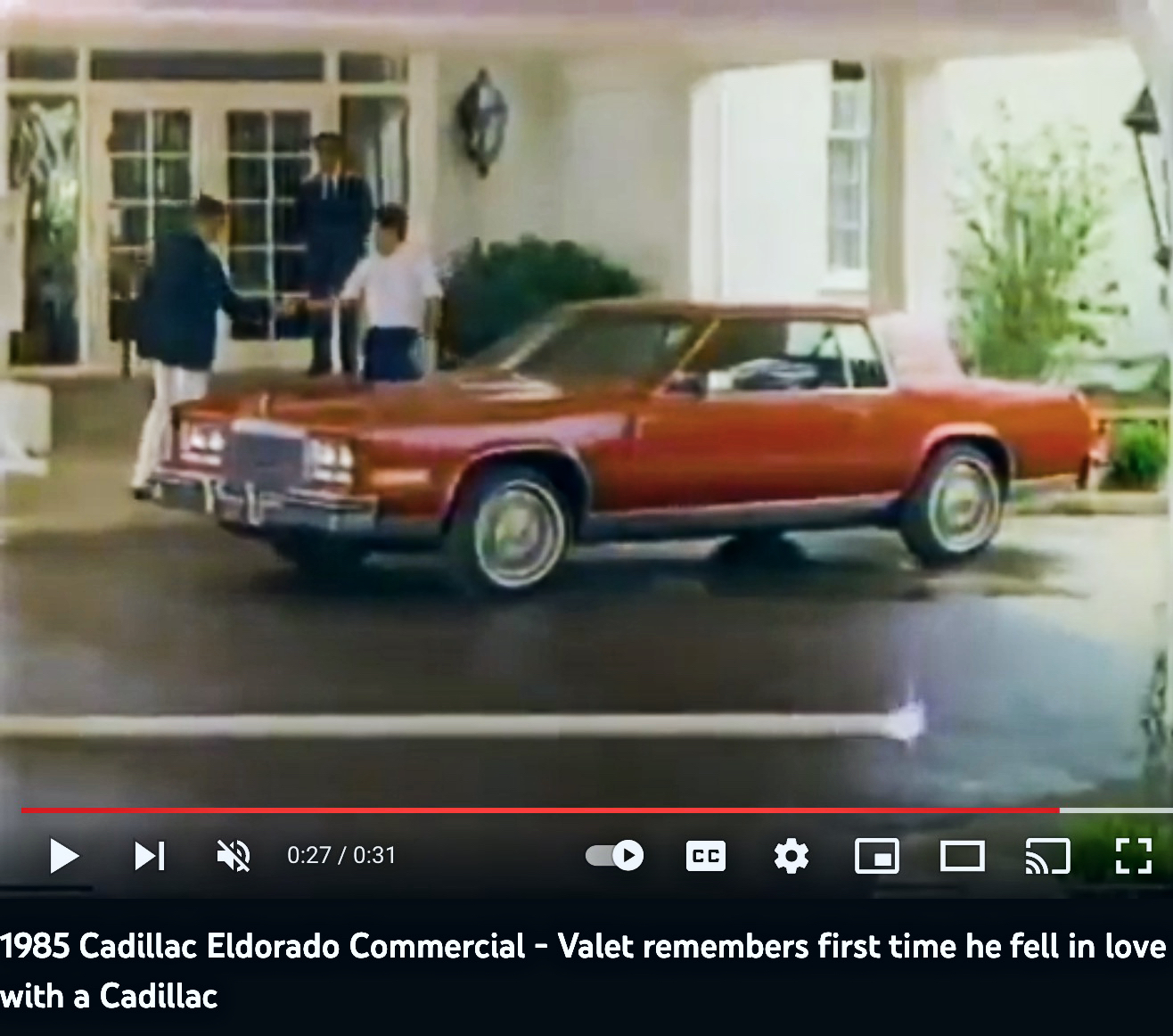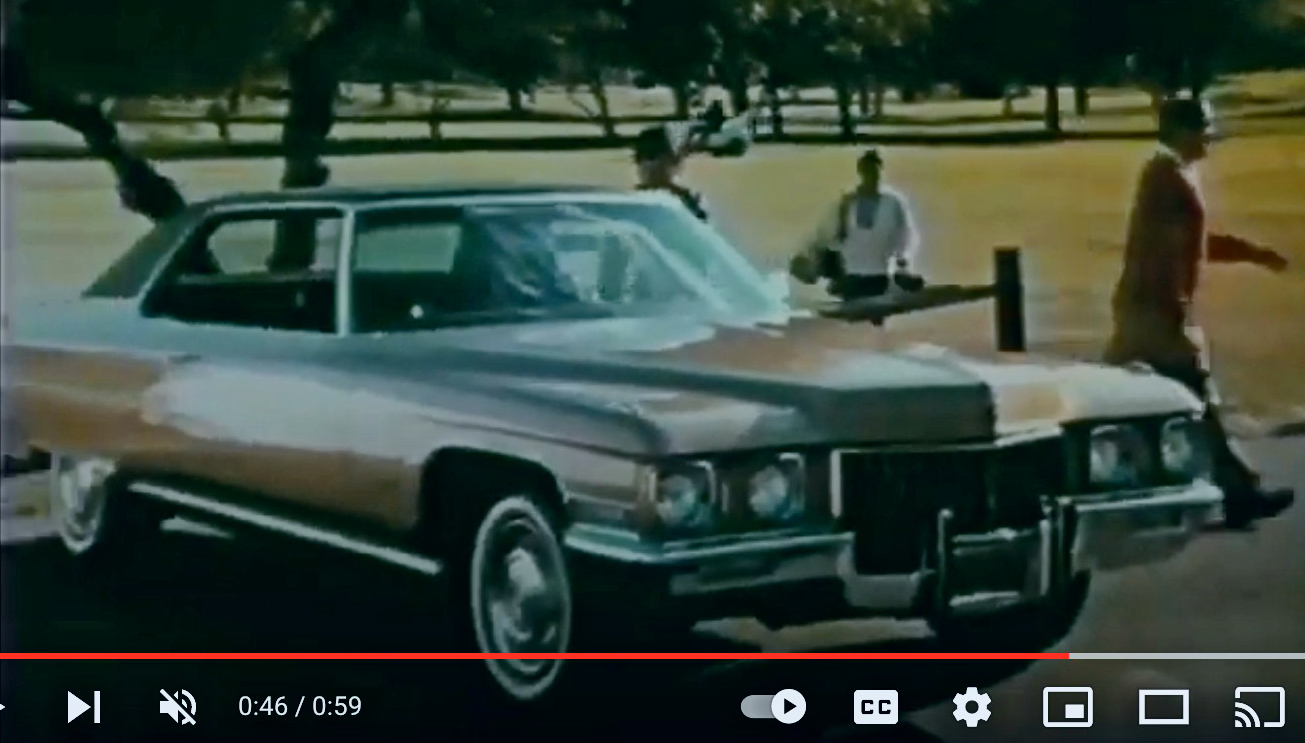
Recently I came across two old Cadillac commercials on Youtube that effectively played on a sentimental vibe many of us car enthusiasts can relate to. The first ad for a 1971 Coupe de Ville opens in black and white with a teenage boy admiring a passing 1937 Cadillac Fleetwood on the golf course where he’s working as a caddy. An announcer says, “Even back then, you knew that someday… you’d own a Cadillac”. The boy’s face blends into him now (in 1971) as a middle- aged man piloting his own ’71 Caddy with a satisfied grin on his face. While the car’s luxury virtues are extolled, the middle-aged guy pulls into fancy-looking golf course entrance gates. As he parks and gets out, he waves to a teenager who’s going to be carrying his clubs.

The 1971 teen looks longingly at the new Cadillac, and the announcer closes out the commercial by tying it back to the beginning, “…because, someday”. The 1985 Eldorado commercial is similar, with a middle-aged owner flashing back to being awe-struck behind the wheel of a new 1967 or ’68 Eldorado as a golf club valet – the same way a young current-day valet is looking at his ‘85 Eldo.
If you’re reading this, then you understand that’s how the love affair with cars often begins. We covet what we see every day, especially during our younger formative years. I can relate to the sentiment in both of these commercials – particularly the 1985 one because that’s when I was young. As a college student in the late 1980s, I had a number of jobs revolving around cars. In the summers, I was a technician at a Chevrolet dealer near my house.
During the school year, I worked as a valet for a service that supplied valets to restaurants and clubs all over the place. Other times, I worked for a big auto auction warehouse. For a car fanatic such as myself, these were great ways to get behind the wheel of lots of vehicles I could only dream of owning at age 19 or 20 – even if it was only for a moment at a time. Collectively, these experiences shaped what I learned to appreciate.
Back to the Cadillac commercials. When I was a valet, 1979-85 style Eldorados were plentiful, and I really liked the look and feel of them. In many ways, I was the young guy appearing at the end of the 1985 commercial. But now that I’m middle-aged with more potential to afford a new Cadillac, I had to ask myself if there are any current models with the same appeal that 1970s and ‘80s Eldorados, Fleetwoods, de Villes, and Sevilles had for me.
According to the automotive press, today’s Cadillac CT4 and CT5 sedans are great-handling, well-made vehicles. But, for what they cost new these days, they just don’t stir that “must-have” feeling. If Cadillac’s larger CT6 sedan hadn’t been dropped after 2020, it would be a strong possibility. I don’t say this lightly, because I actually drove out to Detroit during spring break of 1990 to visit GM’s Hamtramck plant (among others) where Cadillac Eldorados and Sevilles were produced at the time.
I sat down and gave this issue some thought, asking myself are there any other 1980s vehicles I wanted when I was young that I would still want today’s version of? Ones that I looked at and thought, “someday…”. To answer that question, I had to make a couple of lists because there were plenty of cars I lusted after.

Starting with the large luxury vehicle field, my standout favorites were various 1980s Cadillac models, the 1980-89 Lincoln Town Car, and the 1980-91 Mercedes “W126 body” S-class. From the 4×4 field, new Chevy Suburbans and Blazers with 2-tone paint and tinted glass were also at the top of my someday list. I also recall seeing one or two specially-imported versions of Mercedes’ Gelandewagen SUV during the mid-‘80s before laws changed to prevent gray-market importation during 1986. All of them had an unmistakable presence outside and inside, and when you slid behind the wheel, you felt like you were piloting something special.
Honorable mentions in this category would be the full-size Chevrolet Caprice and Ford LTD (after the 1988 update). Unlike today’s cars with sport suspensions and low-profile tires that transmit every lump and bump in the road, these old cruisers floated and steered with the same panache as a Rolls-Royce. Whether or not any of them were thought of as “old people cars” was of zero concern to me because I liked what I liked. When I thought about it, though, I realized all of these designs first hit the roads when I was in elementary school years earlier. Maybe that was part of the appeal, but it’s hard to say for sure.
Next for consideration is my list of cars that are more in line with what you’d expect a teenager to want in the late 1980s – rear-wheel-drive sports coupes. Featuring pop-up headlights, there were the 1986-92 Toyota Supra, 1986-91 Mazda RX-7, 1984-96 C4 Corvette, 1984-89 Nissan 300ZX, and the 1983-89 Mitsubishi Starion/Chrysler Conquest – all cars I lusted after but couldn’t afford. Without pop-up headlights, there were the refreshed 1987-93 Ford Mustang, 1983-88 Mercury Cougar, 1982-92 Chevrolet Camaro, and 1978-88 Chevrolet Monte Carlo. Perhaps the ultimate sport coupe would have been a red 1986-89 Mercedes 560SL.

Time warping back to today, many of the models on my lists have been discontinued without a comparable product to take their place. For example, there are no full-size, rear-wheel-drive Ford, Lincoln, or Chevy car models any longer. Rotary-powered Mazda RXs, the entire Mercury brand, Chevrolet’s Monte Carlo, and anything sporty from Mitsubishi were all deleted eons ago. Nissan will soon be offering a redesigned Z model, but as of this writing it’s not yet available for sale.
What models from my original 1980s list are still produced? The Toyota Supra has recently been brought back after a long hiatus, and Chevy’s Camaro lives on after being reborn. Corvettes, Mustangs, Chevrolet Suburbans, and Mercedes S-class and SL models have all seen continuous production since the ‘80s.

Narrowing things down, I’m crossing current versions of the Corvette, Supra, and Mercedes SL off the list right away. Corvette styling lost me after the 1984-96 “C4”, and the current “C8” generation seems to suffer from ungainly proportions that mid-engine vehicles are often cursed with. And maybe I’m old, but Supra styling is just too exaggerated and overdone for me – almost to the point it looks comical from some angles. The Mercedes SL of today is, sadly, a far cry from its clean 1972-89 body style. Given the fact that SLs used to be all over the place in affluent areas but are hard to spot today, I’m clearly not the only one who finds the current design disappointing.
All this cutting leaves the Chevy Suburban, Camaro, Ford Mustang, Mercedes S-class, and Mercedes Gelandewagen (which was finally brought over to the U.S. market officially in 2002).

I studied the current generation of Suburban closely only to realize its front end manages to look excessively massive when viewed from the front, while at the same time appearing strangely minivan-short if viewed from the side or rear three-quarter view. Even though I’ve liked each generation of Suburban since my favorite 1973-91 body style, I can’t say that will happen this time. The same criticism applies to the Cadillac Escalade version as well.

A number of friends owned Mustang GTs and Camaro Z28s in the old days, and I was regularly envious. I like the smooth yet aggressive lines of today’s Mustang and Camaro, both of which are available in convertible form with V8 power and manual transmissions just as they were in the 1980s – a fact I really appreciate. However, after close scrutiny, the high belt line and small window openings both are needlessly afflicted with seems to give them a chunky, overweight look. I dropped both of them down a few points for this.

As far as the Mercedes S-class, the 1980-91 “W126” generation was always an aspirational design – so much so that, some years ago, I picked up a very nice long-wheelbase ‘80s SEL sedan used to keep in the garage for nice days. Even though the new 2022 S-class and Maybach S-class are better looking than they’ve been for a few generations, they just don’t stand out as much as the W126 from the 1980s did. So they weren’t an automatic win either.
Left undiminished is today’s Mercedes Gelandewagen (“G-Wagen” for short), which seems right as a personal “someday” choice despite the fact I hadn’t seriously considered it until this point. In the mid-‘80s as teenager, I do remember seeing them on the roads here and there because, while the G-Wagen was born as a military vehicle in 1979, it was never officially imported to the United States before 2002. Until 1986, U.S. laws allowed individual vehicles to be imported privately. Wealthy folks did just that, bringing “gray market” European versions of G-Wagens and other models over.

A G-Wagen 2- or 4-door SUV was easy to spot in those early days because they looked so unlike anything else that they were practically exotic. Often, they were imported with diesel engines to avoid U.S. emissions requirements. I’d look at the big Mercedes emblem in the center as one of them went by and think, “yeah – rad, man. I want one of those”. Or something like that, it was the 1980s. But in the end, choosing the Gelandewagen as a someday car is easy because that first generation design ran from 1979 all the way through 2018. Additionally, the second- generation redesign is so close to the first one that it’s hard to tell them apart.
So if I end up with a winning lottery ticket, a new G-Wagen is how I’ll pay modern tribute to early automotive wishes.

































